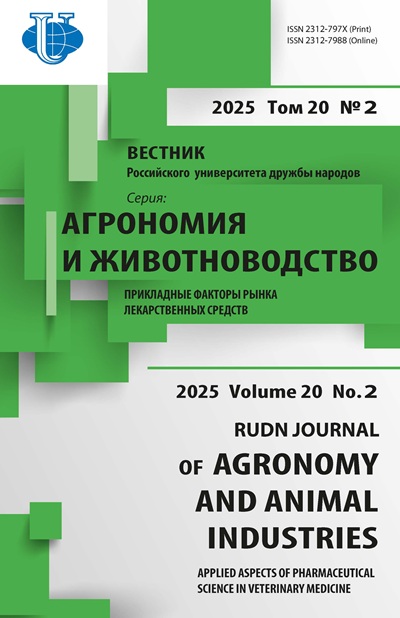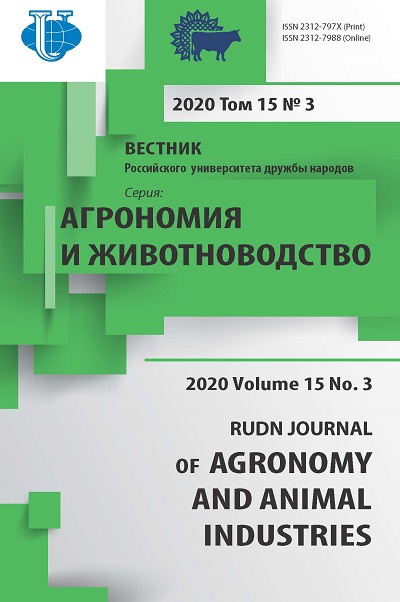Cfa-miRNAs-122 and -21 as modern biomarkers of primary hepatitis in dogs
- Authors: El-Sebaey A.M.1,2, Abramov P.N.1, Borunova S.M.1
-
Affiliations:
- Moscow State Academy of Veterinary Medicine and Biotechnology - MVA named K.I. Skryabin
- Mansoura University
- Issue: Vol 15, No 3 (2020)
- Pages: 294-307
- Section: Veterinary science
- URL: https://agrojournal.rudn.ru/agronomy/article/view/19588
- DOI: https://doi.org/10.22363/2312-797X-2020-15-3-294-307
- ID: 19588
Cite item
Full Text
Abstract
Primary hepatitis (PH) is one of the most frequently diagnosed hepatic diseases in dogs. Its popular forms are acute hepatitis (AH) and chronic active hepatitis (CAH) which can progress to hepatic fibrosis and cirrhosis. This investigation aimed to evaluate the use of hepatocyte released Canine familiaris miRNAs(cfamiR)-122 and -21 as serum biological markers for the early and reliable diagnosis of PH and to reveal the onset of hepatic fibrosis. After the ultrasonographic and histological examination, fifteen healthy dogs were involved in the study as control group to compare with other thirty dogs confirmed to have AH or CAH (n = 15). Activity of liver enzymes as well as serum level of globulin and total bilirubin were significantly elevated in AH (P < 0.001) and CAH (P < 0.01) groups whereas, serum level of total protein, albumin, BUN and A/G ratio were significantly lowered in both PH groups (P < 0.01) compared to control. Cfa-miR-122 significantly expressed in AH (P < 0.001) and CAH (P < 0.01) and exhibited a potential significance in distinguishing these groups from control with an area under the curve (AUC) of 0.98 and 0.96, respectively. Additionally, cfa-miR-122 displayed a potential role in distinguishing AH (P < 0.05) from CAH group with an AUC of 0.85. Cfa-miR-21 was only expressed in dogs of CAH group and displayed a potential role in distinguishing this group (P < 0.001) from AH and healthy groups with an AUC of 0.99 and 0.88, respectively. Therefore, cfa-miR-122 can be significantly expressed in dogs with two forms of PH whereas, cfa-miR-21 could be potentially enhanced only in chronic form of PH and may act as new non-invasive biomarker for distinguishing AH from CAH.
Keywords
About the authors
Ahmed Mohammed Hassan El-Sebaey
Moscow State Academy of Veterinary Medicine and Biotechnology - MVA named K.I. Skryabin; Mansoura University
Author for correspondence.
Email: dr_sebaey@mans.edu.eg
Postgraduate student, Department of Diagnostics of Diseases, Therapy, Obstetrics and Animal Reproduction ; assistant lecturer, Department of Clinical Pathology, Faculty of Veterinary Medicine, Mansoura University
23 Akademika Skryabina st., Moscow, 109472, Russian Federation; 25 El Gomhouria st., Mansoura, 35516, EgyptPavel Nikolaevich Abramov
Moscow State Academy of Veterinary Medicine and Biotechnology - MVA named K.I. Skryabin
Email: Abramov_P@inbox.ru
Candidate of Veterinary Sciences, Associate professor, Department of Diagnostics of Diseases, Therapy, Obstetrics and Animal Reproduction
23 Akademika Skryabina st., Moscow, 109472, Russian FederationSeidfatima Mirovna Borunova
Moscow State Academy of Veterinary Medicine and Biotechnology - MVA named K.I. Skryabin
Email: fatima.borunova@mail.ru
Doctor of Biological Sciences, Professor, Department of Diagnostics of Diseases, Therapy, Obstetrics and Animal Reproduction
23 Akademika Skryabina st., Moscow, 109472, Russian FederationReferences
- Poldervaart JH, Favier RP, Penning LC, Ingh TVD, Rothuizen J. Primary Hepatitis in Dogs: A Retrospective Review (2002-2006). Journal of Veterinary Internal Medicine. 2009; 23(1): 72-80. doi: 10.1111/j.1939-1676.2008.0215.x.
- Dirksen K, Verzijl T, Ingh TVD, Vernooij J, Laan LVD, Burgener I, et al. Hepatocyte-derived microRNAs as sensitive serum biomarkers of hepatocellular injury in Labrador retrievers. The Veterinary Journal. 2016; 211:75-81. doi: 10.1016/j.tvjl.2016.01.010.
- Meyer HP, Rothuizen J. History and physical examination. In: Washabau RJ, Day MJ. (eds). Canine & Feline Gastroenterology. St. Louis, MO: Elsevier Saunders; 2013.
- Eulenberg VM, Lidbury JA. Hepatic Fibrosis in Dogs. Journal of Veterinary Internal Medicine. 2017; 32(1):26-41. doi: 10.1111/jvim.1489.
- Raghu C, Ekena J, Cullen JM, Webb CB, Trepanier LA. Evaluation of potential serum biomarkers of hepatic fibrosis and necroinflammatory activity in dogs with liver disease. Journal of Veterinary Internal Medicine. 2018; 32(3):1009-1018. doi: 10.1111/jvim.15064.
- Larson MM. Ultrasound Imaging of the Hepatobiliary System and Pancreas. Veterinary Clinics: Small Animal Practice. 2016; 46(3):453-480. doi: 10.1016/j.cvsm.2015.12.004
- Craig SM, Fry JK, Hoffmann AR, Manino P, Heilmann RM, Suchodolski JS, et al. Serum C-reactive protein and S100A12 concentrations in dogs with hepatic disease. Journal of Small Animal Practice. 2016; 57(9):459-464. doi: 10.1111/jsap.12504.
- Schueller F, Roy S, Vucur M, Trautwein C, Luedde T, Roderburg C. The Role of miRNAs in the pathophysiology of liver diseases and toxicity. International Journal of Molecular Sciences. 2018; 19(1):261-269. doi: 10.3390/ijms19010261.
- Dirksen K, Verzijl T, Grinwis G, Favier R, Penning L, Burgener I, et al. Use of Serum MicroRNAs as Biomarker for Hepatobiliary Diseases in Dogs. Journal of Veterinary Internal Medicine. 2016; 30(6):1816-1823. doi: 10.1111/jvim.14602.
- El-Sebaey AM, Abramov PN, Abdelhamid FM. Clinical Characteristics, Serum Biochemical Changes, and Expression Profile of Serum Cfa-miRNAs in Dogs Confirmed to Have Congenital Portosystemic Shunts Accompanied by Liver Pathologies. Veterinary Sciences. 2020; 7(2):35-41. doi: 10.3390/vetsci7020035.
- Huang Q, Zhang X, Bai F, Nie J, Wen S, Wei Y, et al. Methyl helicterte ameliorates liver fibrosis by regulating miR-21-mediated ERK and TGF-β1/Smads pathways. International Immunopharmacology. 2019; 66:41-51. doi: 10.1016/j.intimp.2018.11.006.
- Feldman AT, Wolfe D. Tissue Processing and Hematoxylin and Eosin Staining. In: Day C. (ed). Histopathology. Methods in Molecular Biology (Methods and Protocols). Vol. 1180. New York: Humana Press; 2014. p. 31-43. doi: 10.1007/978-1-4939-1050-2_3.
- El-Sebaey AM, Abramov PN. Circulating hepatocyte derived microRNA as a diagnostic biomarker of gallstone disease in dogs. Veterinarian. 2020; 2:64-73. (In Russ). doi: 10.33632/1998-698Х. 2020-2-64-73
- Livak KJ, Schmittgen TD. Analysis of relative gene expression data using real-time quantitative PCR and the 2-ΔΔCT method. Methods. 2001; 25(4):402-408. doi: 10.1006/meth.2001.1262.
- Kirkwood BR, Sterne JAC. Essential Medical Statistics. 2nd ed. Oxford: Blackwell; 2003.
- Eman SR, Kubesy AA, Baraka TA, Torad FA, Shaymaa IS, Mohammed FF. Evaluation of hepatocytederived microRNA-122 for diagnosis of acute and chronic hepatitis of dogs. Veterinary World. 2018;11(5):667-673. doi: 10.14202/vetworld.2018.667-673.
- Slivinska LG, Maksymovych IA, Leno MI, Rusyn VI, Chernushkin BO, Rij MB. Visual diagnostics of liver diseases in dogs. Uchenye zapiski UO VGAVM. 2017; 53(2):138-142.
- Bazhibina EB. Algorithm for the diagnostic study of animals with hyperbilirubinemia. Russian veterinary journal. Small domestic and wild animals. 2013; 5(1):29-32.
- Zhao J, Tang N, Wu K, Dai W, Ye C, Shi J, et al. MiR-21 simultaneously regulates ERK1 signaling in HSC activation and hepatocyte EMT in hepatic fibrosis. PLoS ONE. 2014; 9(10): e108005. doi: 10.1371/ journal.pone.0108005.
- Szabo G, Bala S. MicroRNAs in liver disease. Nature Reviews Gastroenterology and Hepatology. 2013; 10(9):542-552. doi: 10.1038/nrgastro.2013.87.
Supplementary files















